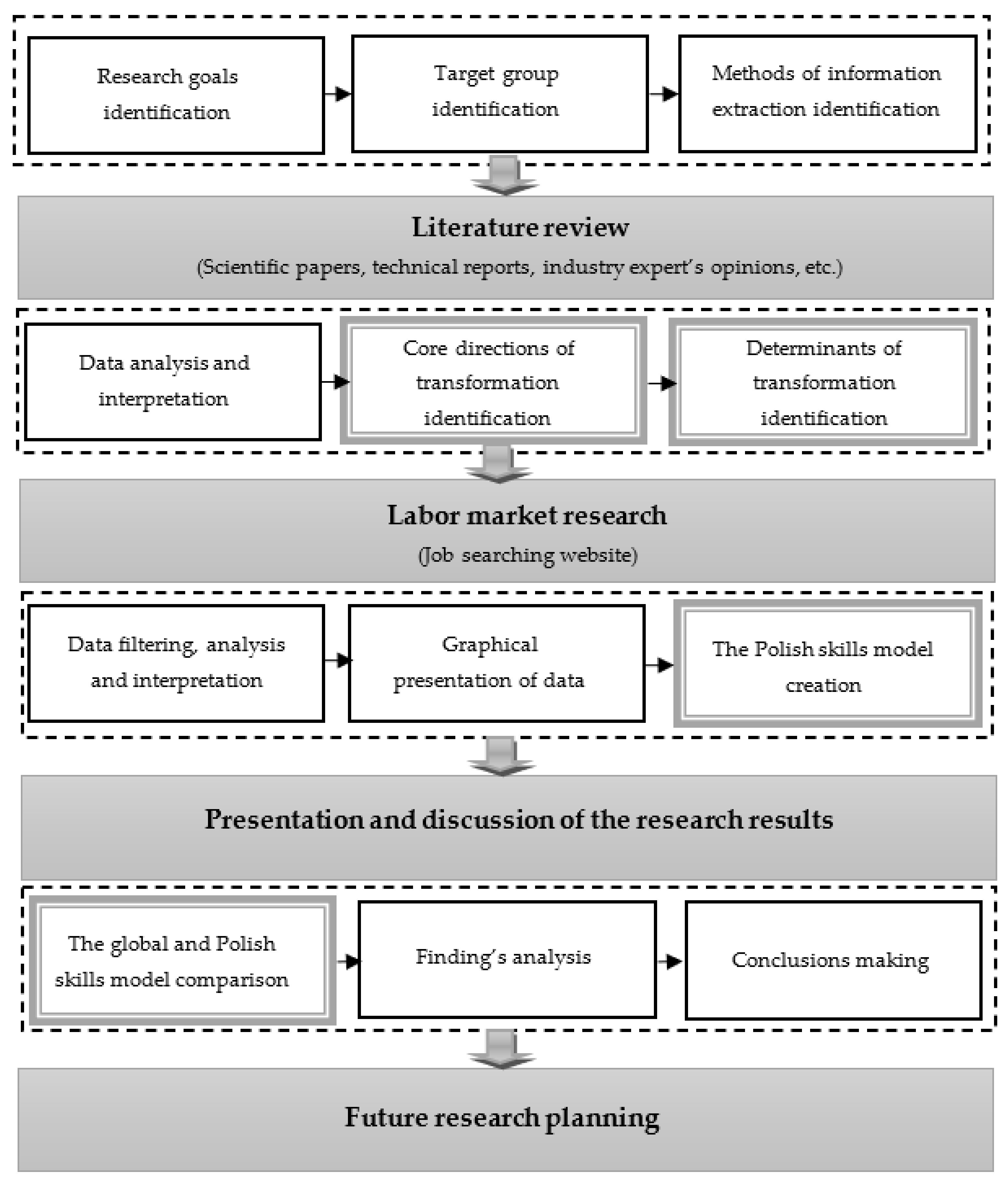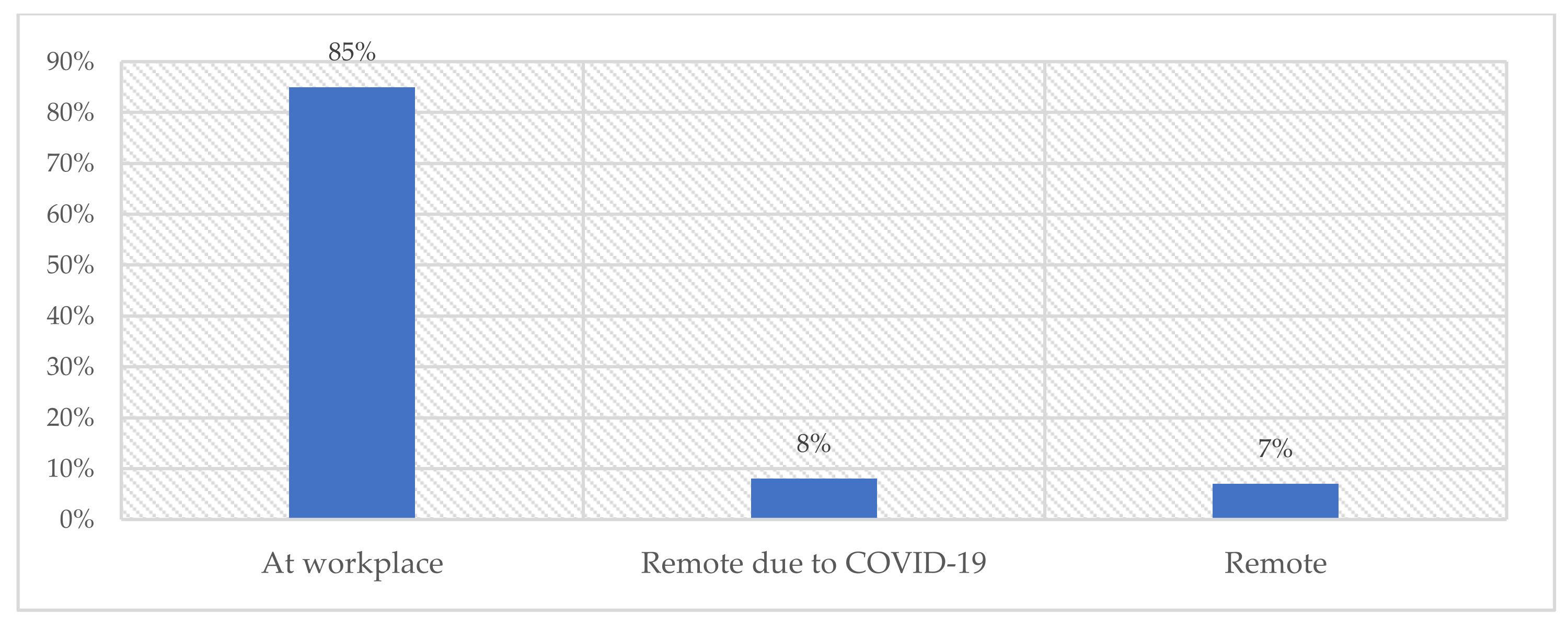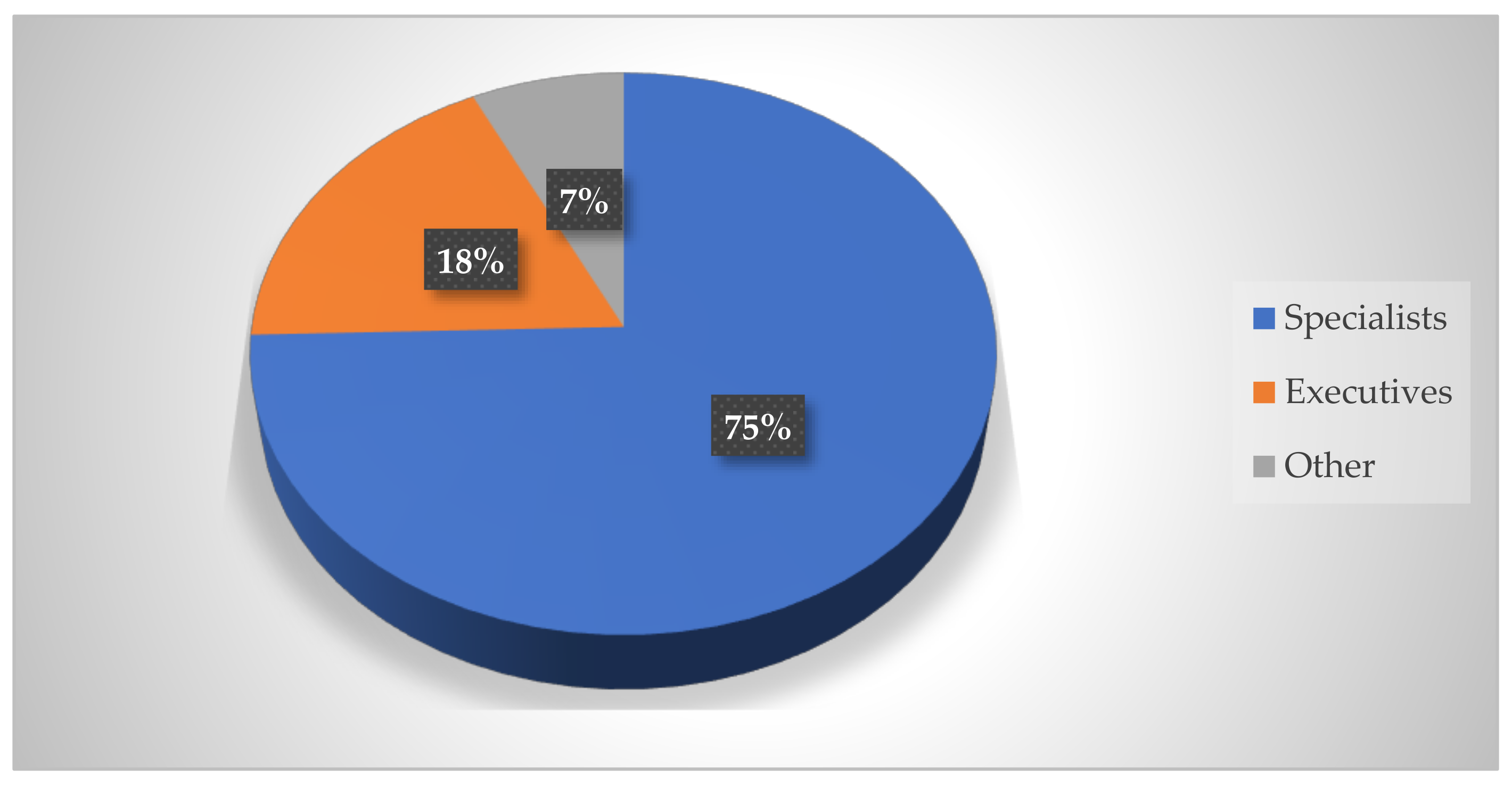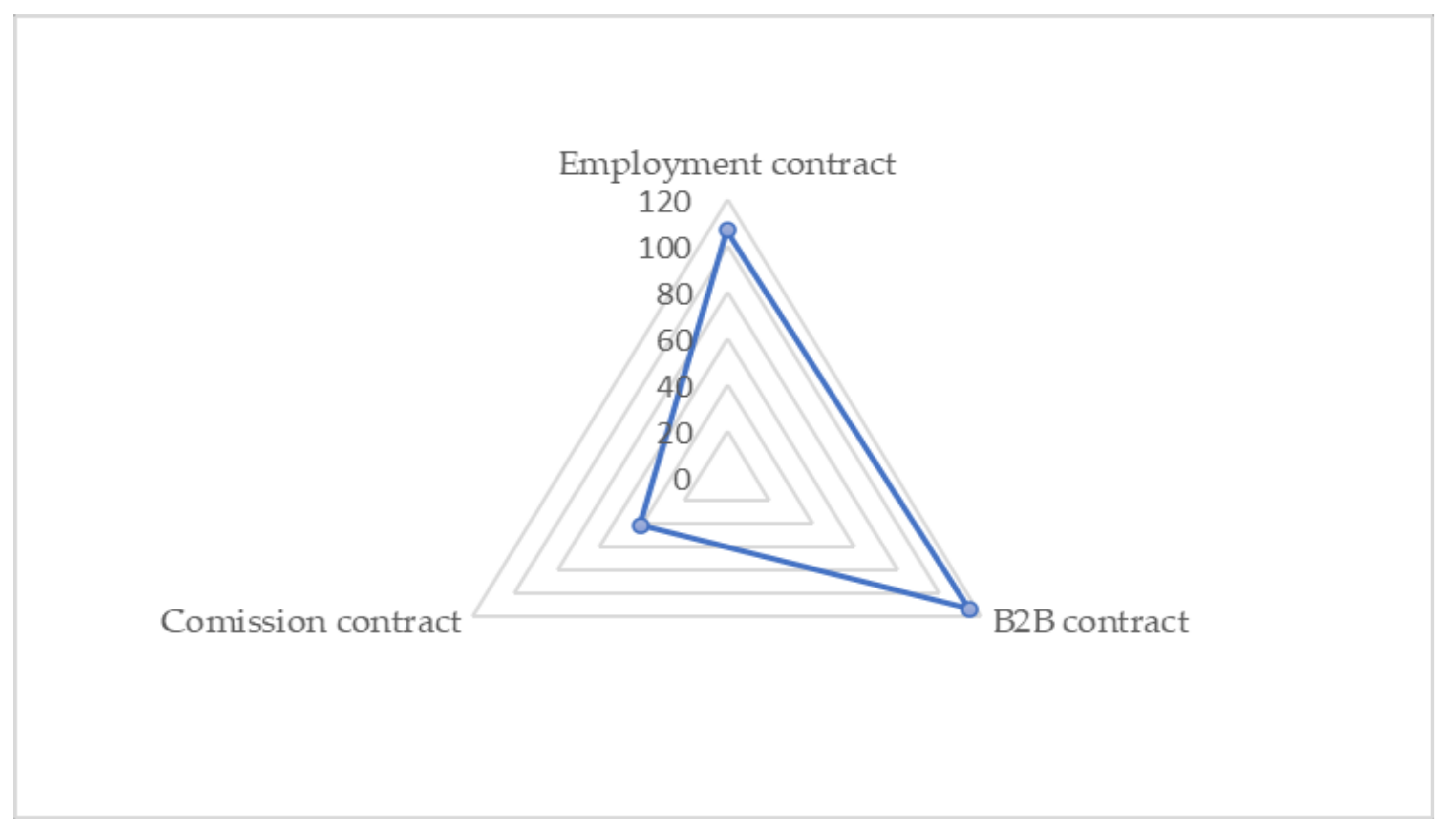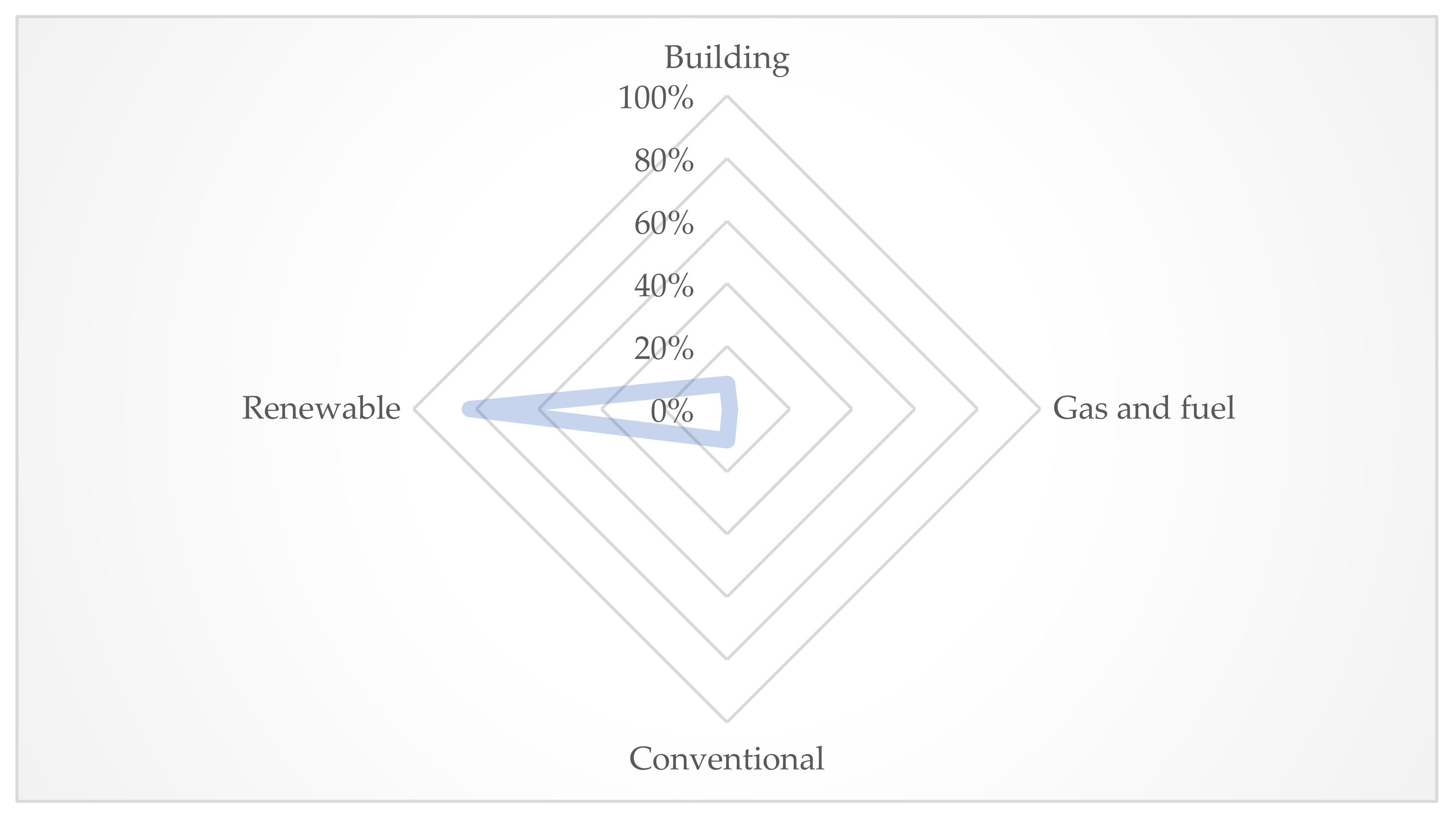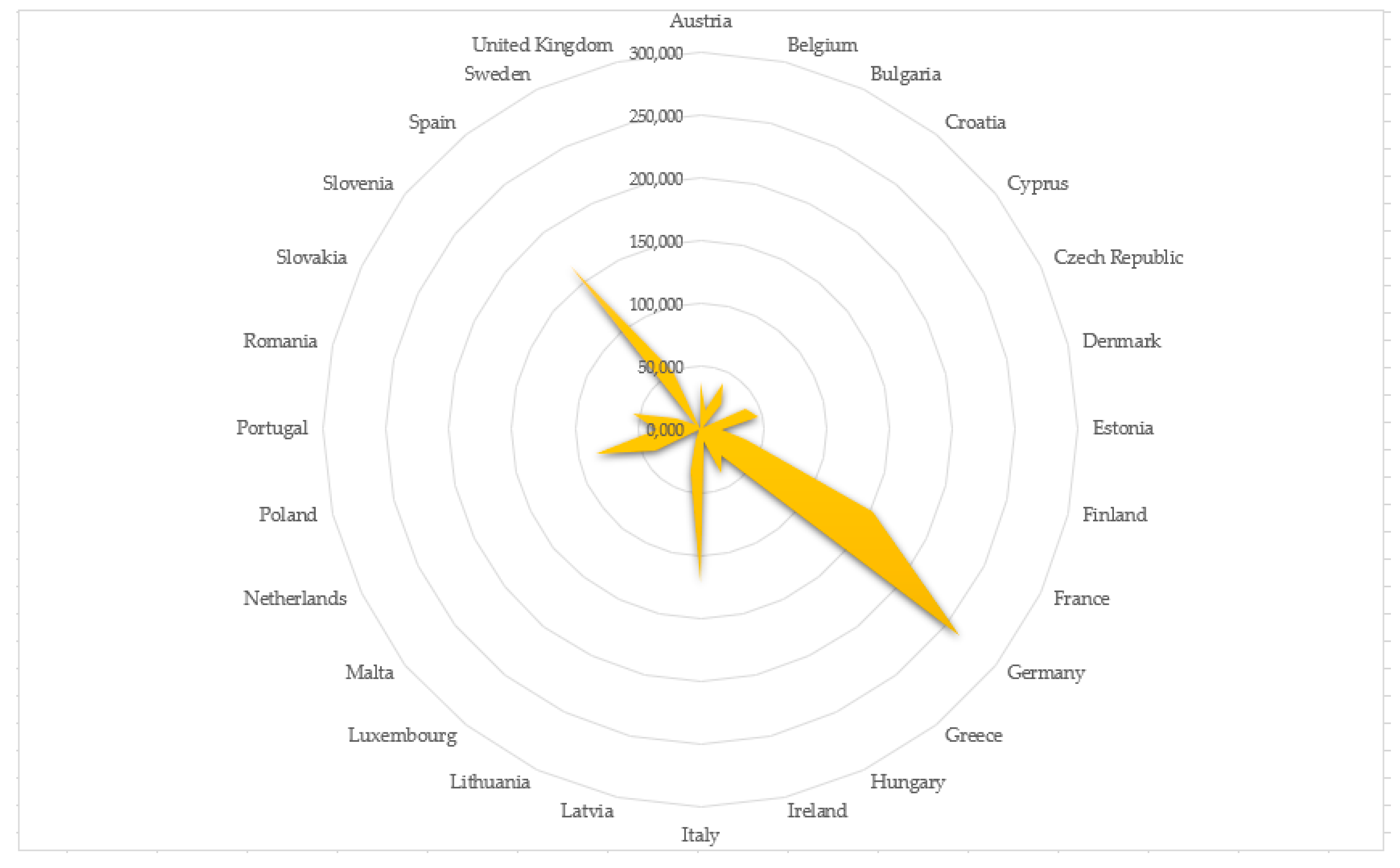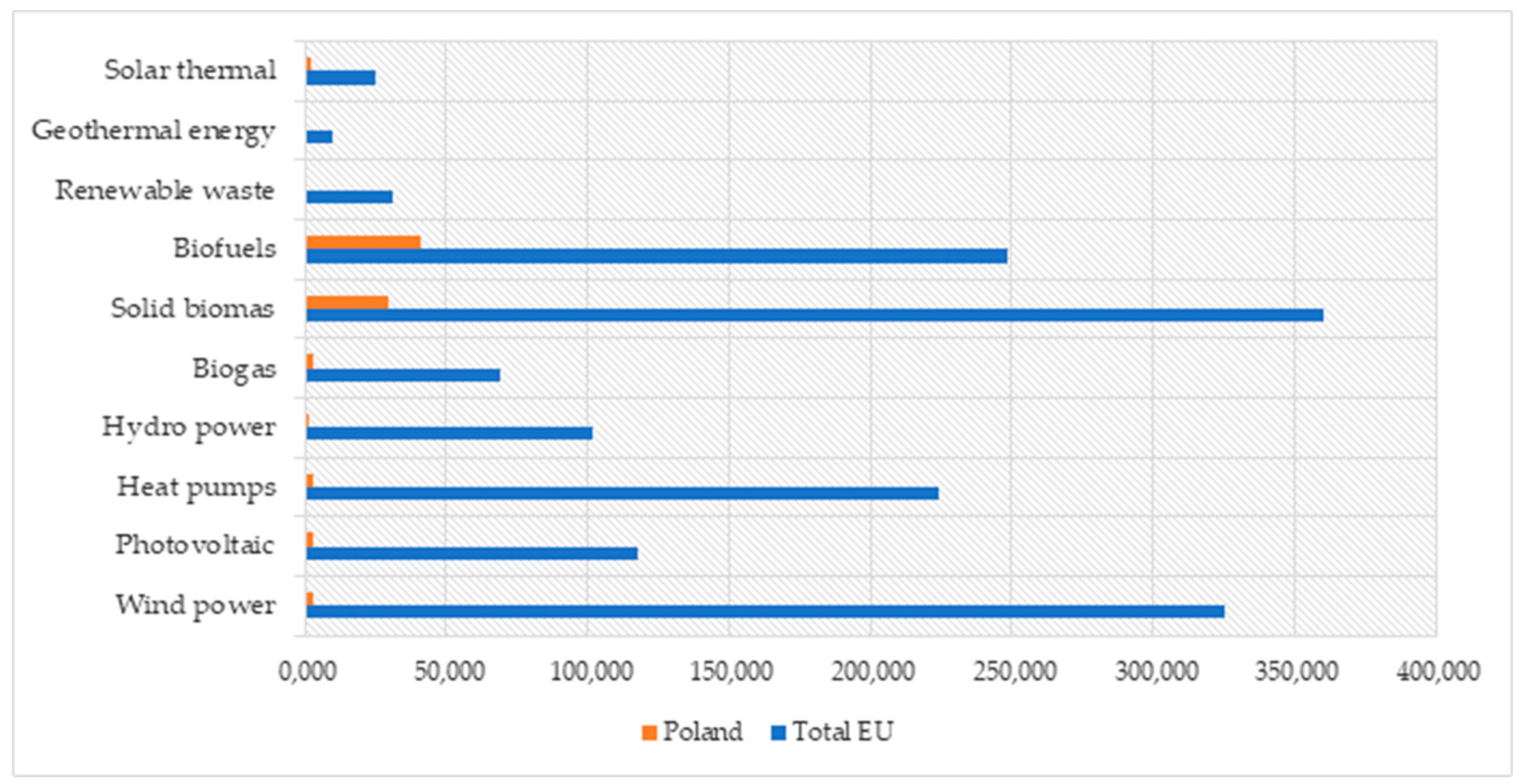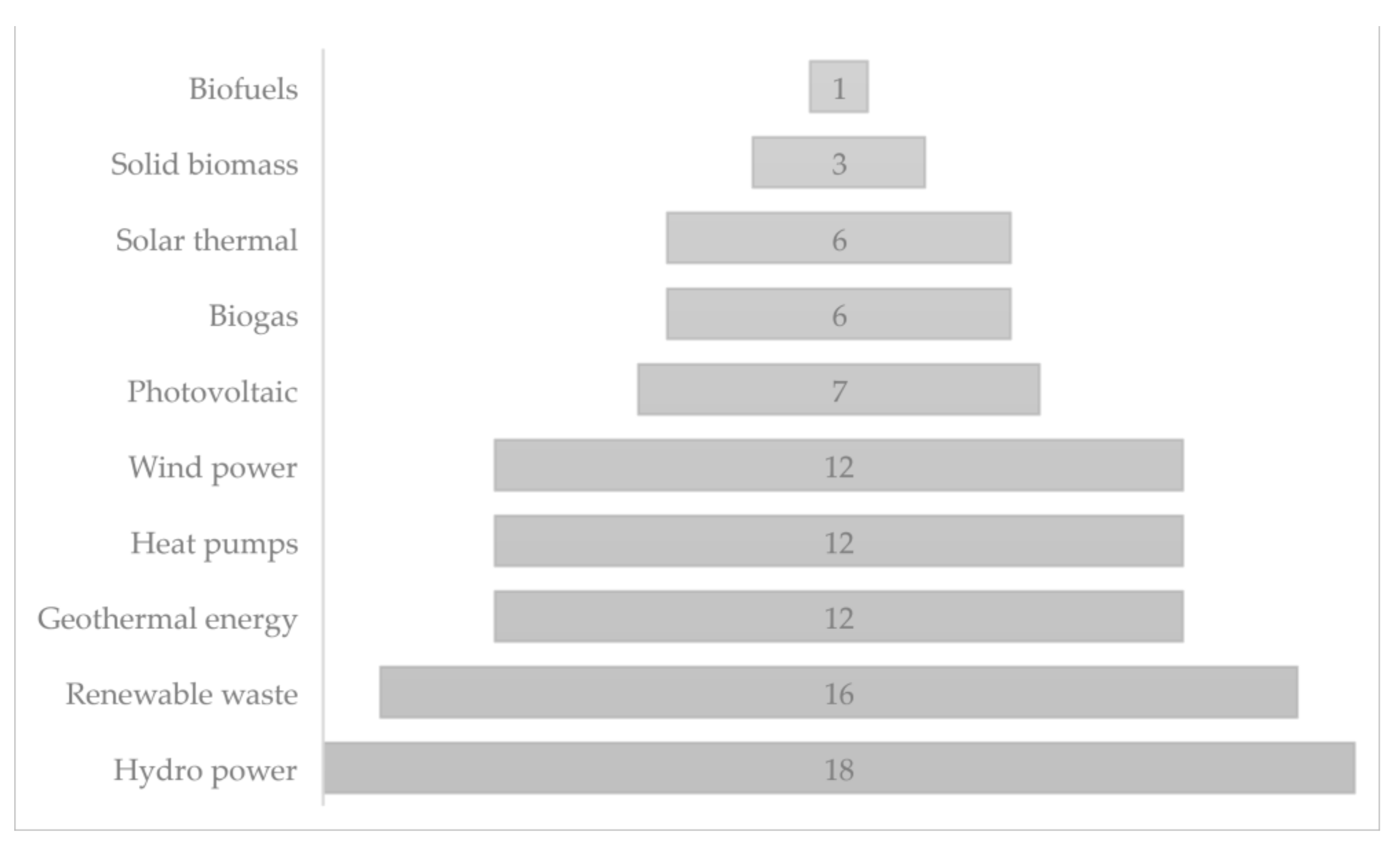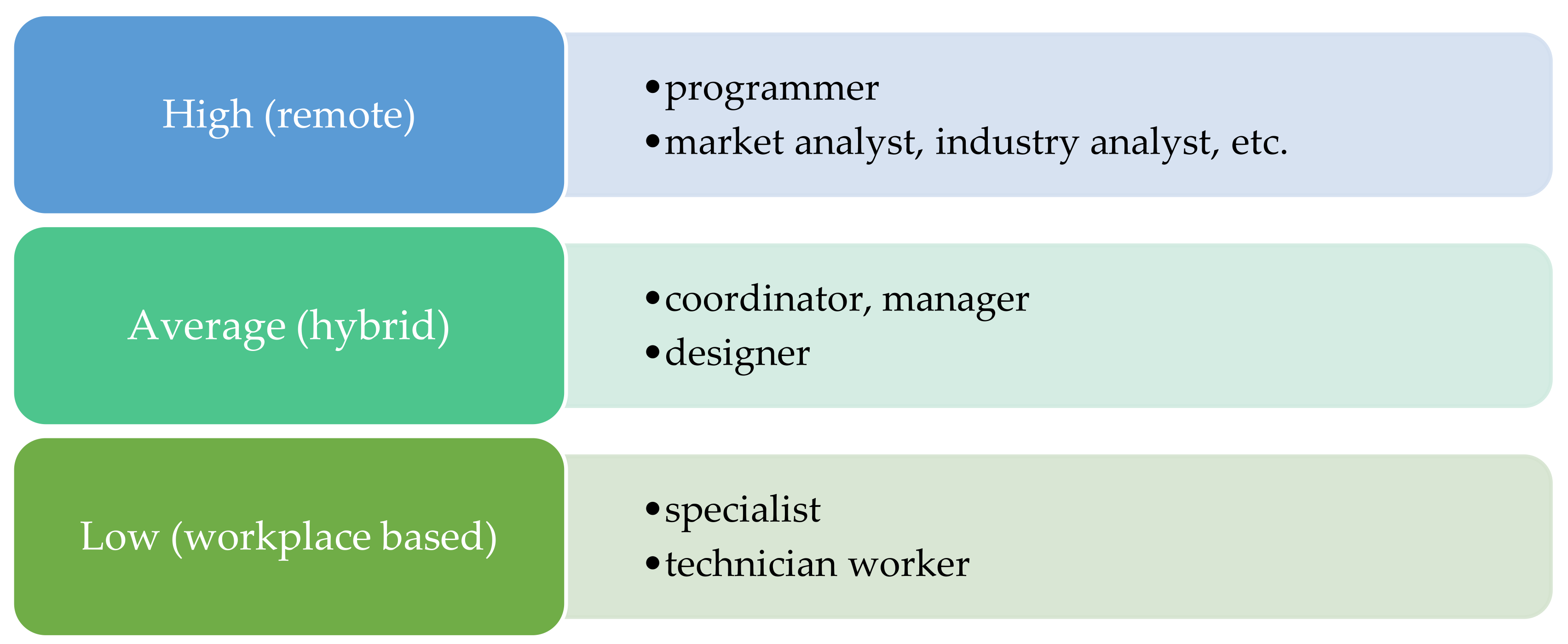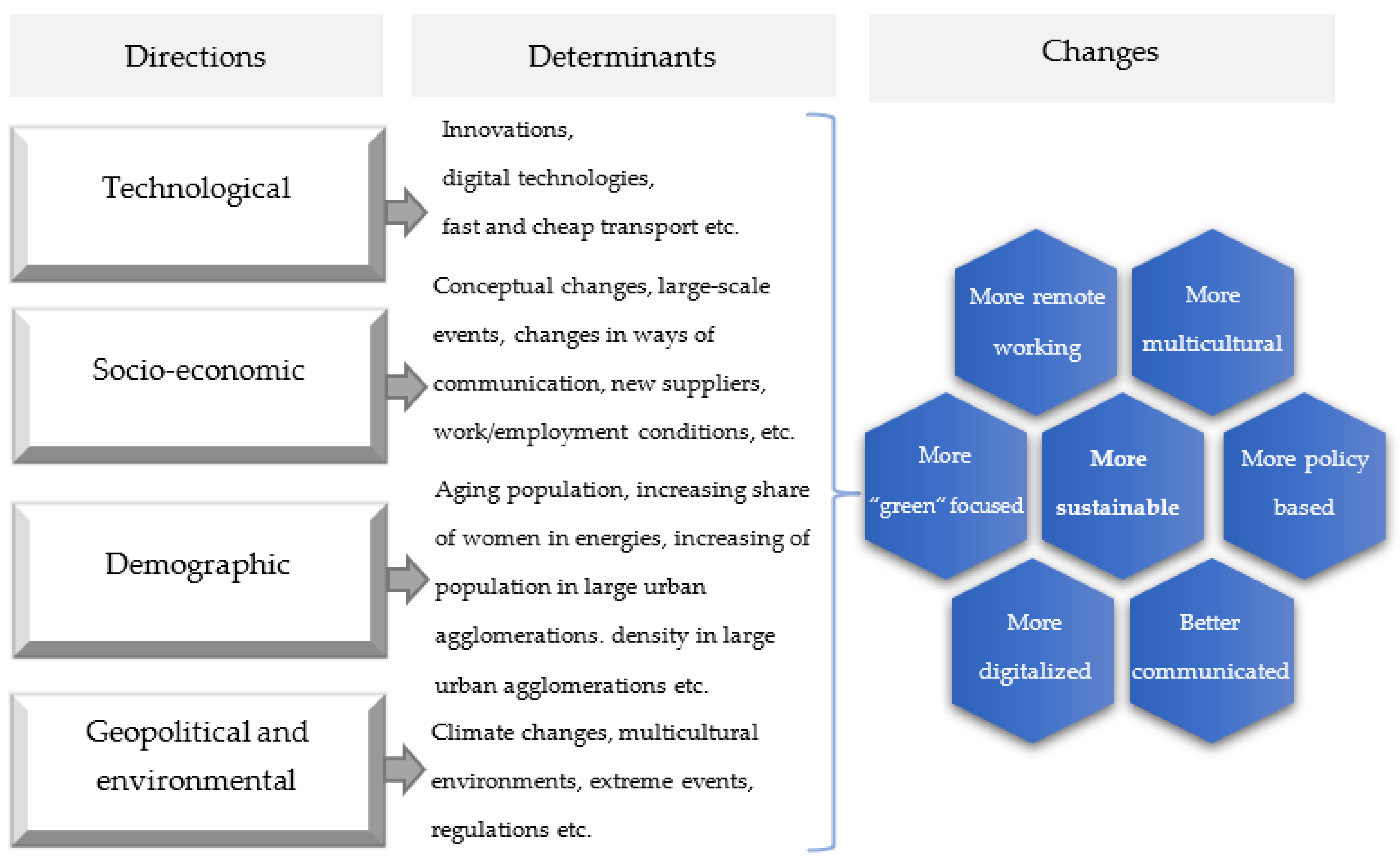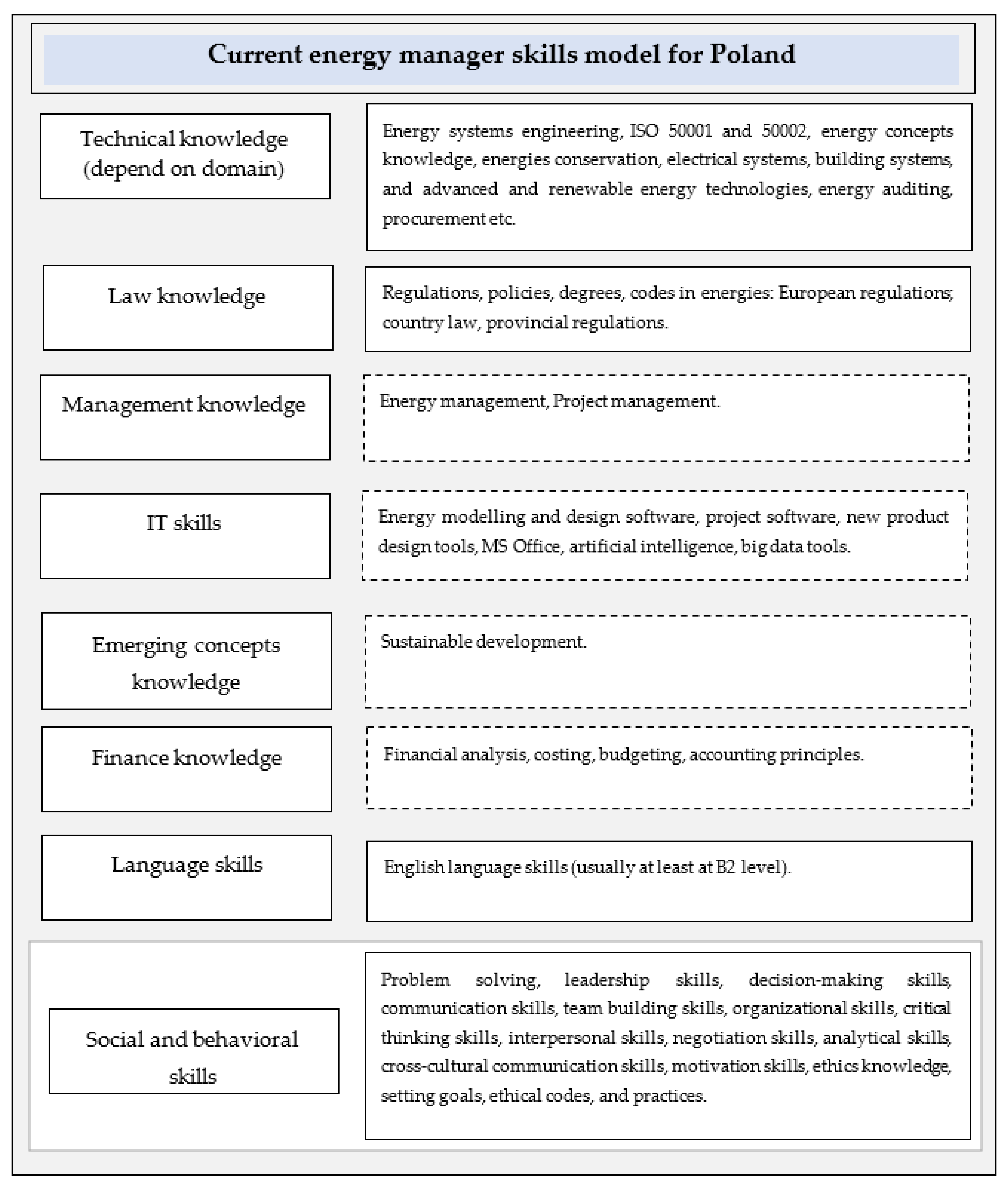1. Introduction
Current technological, socio-economic, geopolitical, and demographic developments and their interconnections will generate new categories of jobs and professions in the near future [
1]. On the other hand, at the same time, they partly or wholly could displace current occupations [
1]. They will change the skills and even skills groups required in both old and new professions in many industries, and will transform workplaces, involving management and regulatory challenges [
1]. By introducing the new skills and competences, organizations will be able to reduce the current skills gaps [
2]. According to the World Economic Forum Report 2020, the skills gap rate in the energy labor market was 70.6% in 2020 [
2].
The COVID-19 pandemic has strongly affected the economic life and the labor markets around the world [
3]. “
The lock-down and other health-related measures implied a slowdown of the business activity” [
3]. The consequences may be considerable for the labor markets, among others: people may have lost their jobs, the absences from work have been increased, new workplaces could have been cancelled or frozen, unemployed people may temporary abandon from job search for family reasons, and employed staff may have reduced their working hours or even stopped working for a time [
3].
According to Eurostat data, “
the EU employment rate (for people aged 20 to 64) went down from 73.1% in 2019 to 72.4% in 2020”. “
At EU level, between 2019 and 2020, the share of employed people usually working from home greatly increased from 5.4% to 12.3%. From 2019 to 2020, the largest declines in terms of temporary contracts in total employment were recorded in Poland (−2.7 percentage points), Croatia (−2.5 percentage points) and Portugal (−2.4 percentage points)” [
3]. On the other hand, the number of job vacancies in March of 2020 went down in EU to 1.6%. Currently, it has increased, and is at a 2.1% level, as before the pandemic [
3].
ILO Monitor also has provided a description of the continuing and devastating impacts of the pandemic on labor markets since early 2020, and the massive disruptions in the labor market that persisted into the fourth quarter of 2020 [
4].
According to research by the World Bank and other several sources, the economic crisis caused by the COVID-19 pandemic severely reduced mobility and economic activity [
5,
6,
7,
8,
9,
10,
11,
12]. In 2021, the World Bank estimated the crisis’ impact on labor markets in 39 countries from April to July 2020. The research results revealed that “
34% of respondents reported stopping work”, “20% of wage workers reported lack of payment for work performed”, “9% reported job changes due to the pandemic” and “62% reported income loss in their household” [
5] (pp. 3–4).
On the other hand, the crisis has accelerated the use of digital technologies. “
This crisis like no other can be an opportunity to leverage digital solutions to set up more permanent mechanisms to expand social protection and to provide vulnerable individuals or firms with adequate incentives to join a national register as a step toward formalization” [
13] (p. 3). Other tools can include a combination of support to small and medium-sized enterprises, as well as tax policies and administration measures [
13].
The changes involved in environmental events have been widely discussed by many authorities. The German Committee on Sustainable Development for Future Earth highlighted the significance of climate change and the transformation of the energy industry during its 2021 Summit [
14,
15]. Thus, it was also proved that the environmental changes have an impact on energy labor markets. The new recommendations are required to achieve sustainability between labor productivity and environmental protection [
16,
17].
One of the most important feedbacks to global changes are green initiatives towards sustainability development such as green finance [
18], green city [
19], and green information processes [
20] and systems [
21].
Likewise, a significant role in energy industry development is played by emerging technologies. Energy executives pointed out that for them, the biggest opportunity was in using innovative cognitive solutions to deliver attractive energy savings and measure business benefits [
22,
23,
24,
25].
The Deloitte company noticed the role of cognitive technologies in the oil and gas sector [
22]. IBM executives argued that cognitive IoT creates insufficient opportunities for the gas and oil industry [
23]. According to the IBM Institute for Business Value Research, in 2016, “
94% of oil and gas executives familiar with cognitive computing believe that it will play a disruptive role in the oil and gas industry” [
24]. A report from the McKinsey Global Institute highlighted how jobs based on human skills will be affected by artificial intelligence (AI) and automation in the future [
26]. The Accenture company, in its “
Future skills pilot”, stated that artificial intelligence will force organizations to create more job pathways [
27]. Millions of jobs may be changed by using machines by 2025. Millions of new roles may emerge by 2025 due these changes [
27]. Moreover, according to the International Monetary Fund, “
the labor market regulations can be simplified to ensure greater flexibility and facilitate informal workers’ entry into formal employment”. “
Digital platforms, including government-to-person mobile transfers, can support new policies generation and contribute to inclusive growth” [
28].
As in many countries of the world, the Polish economy is facing post-COVID environmental and demographic challenges in the years ahead. The research of Długosz, based on opinions of more than 1000 respondents, revealed the negative impact of COVID-19 on society in Poland [
29].
The significant transformation is also waiting for the energy industry. According to a McKinsey report, “
the Polish energy sector needs to close its 48% productivity gap with the EU-15” [
30]. Furthermore, according to a United Nations report, in Poland, self-sufficiency in 2021 was defined at the 58.7% level. Renewable energy share is only 11.4 percent at the moment [
30]. These indexes are planned to be improved by transformation of the energy industry [
31]. The importance of research on the determinants of decarbonization and sustainable energy development in terms of green European and global governance has been highlighted by experts in the Polish energy industry [
32].
Transformations in the energy sector have an impact on the structure of employment. Several problems were identified by researchers; for example, the problem of ensuring a sufficient number of employees with the appropriate competences. Moreover, it should be noted that the population of people working in the power industry is clearly older than the total number of people working. In the near future, the energy industry will have to cope with the wave of retirement departures. These changes involve the need to plan and implement the new competency models for energy enterprises [
33].
Since the role of a modern university is to support the labor markets, its new mission can be defined as “
effectively linking universities with users of knowledge and establishing the university as an important economic actor” [
34]. Universities should offer new education programs, both at the graduate and postgraduate levels, adapted to current energy market requirements.
Above all, in the literature on energy sector, there is a research gap in the influence of the emerging situation of the energy manager’s profession transformation in Poland. Moreover, there is a lack of scientific research on the current skills and abilities of energy managers in Poland.
This paper presents the continuation of research conducted in 2020 [
35]. However, this time it is focused on the main directions of the transformation of the energy manager profession, highlighting the differences in skills demanded and weak points of the labor market in Poland.
The purpose of the paper is to identify the main directions and determinants of this profession transformation, with special attention paid to the impact of emerging technologies and emerging concepts.
The research tested the hypothesis that the transformation of the energy industry involves the need to modify the skills and competences of energy managers in Poland to prepare them for the implementation of the low-emission transformation plan by 2040. To this purpose, a comparison of was made of the two models: the global energy manager skills model, and the Polish energy manager skills model.
To analyze the main aspects of the transformation of the energy manager profession in Poland, a hybrid research approach based on a literature study and a labor market analysis was used (
Figure 1). The approach was adapted from previous research [
35] and extended to add the new tasks. In particular, the determinants involved changes in energy management and the energy manager profession in Poland were identified. Moreover, the current skills of energy managers were identified and compared to a global energy manager skills model created in 2020 [
35]. The differences in skills and competences required were described and highlighted.
This paper consists of five main parts. In the Introduction, the implications, research methodology, and research framework are presented and described. After the Introduction, a literature study outlining the core directions and determinants of the energy manager profession’s transformation is reported. The literature study is followed by a labor market study, and a discussion of the results and limitations of this research. Finally, conclusions and the future research perspectives are discussed.
2. Literature Review
According to Gita Bhatt, the pandemic accelerated the digital future, and digitalization is coming at us faster than ever before. It will transform the economic and social spheres [
36]. The pandemic has also accelerated the process of substituting machines for workers [
37].
There are different opinions: some argue that automation is the price humans pay for prosperity, and new technologies will increase productivity and incomes; and on the other hand, they can dislocate some workers and disrupt existing businesses and industries [
38].
Current changes in emerging technologies were influenced by several enablers.
The first are mobile technologies and the Internet, connecting individuals and enterprises with information and providers of financial services [
39]. People have become more mobile with political and cultural globalization, the development of Internet and information technologies, and possibilities of fast and cheap transport. For employers, this means that employees are easier to lose, but easier to find as well. In 2021, in line with current trends, the Workplaceless Remote Work Competency Model was created. In this framework of new essential competencies needed to succeed in remote work were described [
40]. This model provides a holistic view of the competencies (attitudes, behaviors, knowledge, and skills) needed in distributed workers, team members, leaders, and executives. According to the model, a new remote leader should have knowledge of change management, performance management, conflict management, team culture, communication management, remote leadership tools, stakeholder management, resource management, and innovations [
40]. The model also suggests changes in ways of communication and highlights the necessity of employees’ skills correction.
A second enabler is the storage and processing of large amounts of data [
39].
Finally, technologies such as cloud computing, artificial intelligence and cognitive technologies, distributed ledger technology, and biometric technologies have a significant influence. Moreover, “
at the core of all these innovations is the ability to gather information and reach users at a very low cost” [
39].
J. Kubicka argued that from the perspective of entrepreneurship and the labor market, re-skilling of mining sector employees is not an easy task and will not become one; however, by providing for professional cooperation between experts, enterprises, temporary employment agents, head-hunters, and other stakeholders, such a change can be introduced as a fair transformation [
41].
It is necessary to make up for deficiencies in the labor market by competing for talents and the most competent employees, even from other countries, which is a long-lasting and difficult process in view of cultural differences [
41].
With the noticeable climate change, society has noticed the occurring threats, and there is a growing anxiety about life quality [
41].
According to the World Economic Forum, the current drivers of change for the energy industry are new energy supplies and technologies, the changing nature of work, flexible work, climate change, natural resources, and geopolitical volatility [
2].
The pandemic has significantly affected the way of life in many countries.
Drawing on degrowth literature, in the paper “
Coronavirus: Impact on the labor market”, the authors noticed the difference in COVID-19′s impact on different groups of people, especially work losses among men and women, and workers from different age and ethnic groups [
42].
According to Statistics Poland, in the first quarter of 2020, the number of job vacancies decreased from about 150,000 in Q2 and Q3 of 2019 to 78,000. In first quarter of 2021, the number of offers increased to about 110,000 [
43].
Moreover, in the first quarter of 2021, 70,200 thousand jobs were liquidated, 41.5% fewer than in the first quarter of 2020. It should be noted, however, that the number of job cuts related to the spread of COVID-19 accounted for nearly 24% of all job losses. Job losses due to the spread of COVID-19 occurred mainly in the private sector [
43].
It was found that 14.2% of the total number of employed persons in Poland worked remotely on 31 March 2021 due to the pandemic situation [
43]. This was 3.2 percentage points more than at the end of March 2020 [
43]. It was about 20% in the electricity, gas, steam, and air sectors [
43].
According to Dolot, some temporary solutions will remain popular after the restrictions are removed; for example, remote work and more frequent use of digital technologies [
44]. This, in turn, may contribute to permanent changes in the ways in which work is performed, as well as the creation of new jobs.
Summarizing the above, the latest labor market developments caused by the pandemic are continuing workplace closures, working-hour losses, and decreases in labor income. Many authors have proved the impact of COVID-19 on the Polish energy industry.
In the work of Nagaj and Korpysa, the authors studied the impact of COVID-19 on the level of energy poverty in Poland [
45]. Thus, “the authors
proved that “COVID-19 has contributed to the intensification of energy poverty in Poland”. In [
46], Kordel and Wolniak studied the impact of COVID-19 on technology entrepreneurship and the performance of enterprises.
Moreover, Rybak and Rybak studied the impact of the COVID-19 pandemic on gaseous and solid air pollutant concentrations and emissions in Poland [
47]. Bielecki et al. studied the impact of the COVID-19 pandemic on electricity use by residential users [
48].
In the work of Czech and Wielechowski, the authors studied the alternative energy sector’s COVID-19 resistance in comparison to that of the conventional energy sector [
49].
In the work of Dmytrów, Landmesser, and Bieszk-Stolorz, the authors studied the connections between COVID-19 and energy commodity prices. Their analysis revealed that “
the alternative energy sector, represented by the MSCI Global Alternative Energy Index, is more resistant to COVID-19 than the conventional energy sector” [
50].
Other determinants of changes in the energy sector in different countries were described in [
35,
51,
52,
53,
54,
55].
Transformations of the electricity and gas market forced changes in the employment structure in the Polish energy sector [
33]. Market mechanisms forced the energy sector to select suitably qualified personnel. The most sought-after employees in the energy sector included sales, customer service, and call center specialists. In the energy sector, the problem may be to ensure a sufficient number of employees with the appropriate competences [
33]. Moreover, the demand for new competences is unlikely to increase employment, but on the contrary—employment in the energy sector will gradually decrease, mainly due to technological restructuring, which in turn will force organizational restructuring, especially at state-owned energy companies [
33].
The role of digital technologies for the energy industry has been described by many authors [
56,
57,
58,
59,
60,
61,
62,
63,
64,
65,
66].
The technological transformation also became a reality in Poland. Tobias Kurth argued that technologies are needed that can provide accurate measurements, control, and regulation of energy production, and at the same time can consider forecasts in real time. This would involve massive amounts of data: once, one recipient was one data point, and so was one power plant. According to Kurth, in the last phase of transformation; i.e., from 2030, companies will have systems that are fully intelligent and maximally efficient [
67].
In recent years, PKP Energetyka—one of the Polish energy industry leaders—has been undergoing a digital evolution from Company 3.0 to Company 4.0 (in reference to the idea of Industry 4.0) [
68]. The vision of PKP Energetyka 4.0 is based on using the Internet of Things, data analysis (big data), robotization, and automation, as well as artificial intelligence. The newly created Digital Competence Center (Center of Excellence), is responsible for process improvement using the latest digital technologies, such as robot process automation (RPA). The company implemented emerging technologies; in particular, SAP systems; SAP ISU billing systems; iValua procurement management system or IBM Maximo; Planer, e-Tabor, and SAP HR resource management systems; SAP Fiori; Scada; GIS; and hybrid cloud [
68].
Moreover, Enea Operator, another market leader, constantly increases the security of distribution networks through IT-related issues and the pursuit of a smart grid [
69]. For Enea Operator, investing in electromobility and modern network solutions has become one of the most important elements of creating the company’s future business model [
70].
When analyzing the data of the UN report, it could be argued that Poland’s situation is comparable to that of some EU countries; its self-sufficiency rate currently oscillates around 59%. The share of renewable energy, on the other hand, is around 11% [
71].
As officials estimate in the document “
Poland’s Energy Policy 2040”, nuclear power plants in Poland can provide 25,000–38,000 new jobs [
72]. “
The expansion of the generation and grid infrastructure will lead to the creation of an almost new power system by 2040, largely based on zero-emission sources” [
72]. “
Poland will strive to be able to cover the demand for power with its own resources. Domestic coal resources will remain an important element of Poland’s energy security, but the increase in demand will be covered by sources other than conventional coal capacities” [
72]. The goals of PEP2040 are “
energy security, competitiveness, improvement of the energy efficiency of the economy, and reduction of environmental impact” [
72]. On the other hand, one of the sustainable development goals is to provide jobs for the urban regions that were most affected by the decarbonization process.
According to research in 2019 and 2020, about 90% of companies in the energy sector have planned to employ new workers. Moreover, only 46% of companies declared that they have enough competencies to reach the goals, and 51% declared that they have partial competency sources [
73].
According to a 2020 report by Hays, executive salaries in the energy sector in Poland are attractive enough, and vary from PLN 10,000 to 40,000 [
73]. For example, the salary of the director of the photovoltaic department varies from PLN 20,000 to 28,000 [
73]. The high rates create the perspectives for future sustainable employment.
For years, the energy sector in Poland was dominated primarily by employees with secondary and basic vocational educations [
33]. Although there was no one dominant professional group in the power industry, technical specialist professions were relatively important here, as knowledge of the industry and practical skills are of key importance [
33]. Recently, the situation changed, and more job offers for management staff have appeared. Green jobs will replace jobs related to the conventional sector. In addition to avoiding health costs and environmental risks, low-carbon modernization offers the opportunity to stimulate innovation and the emergence of highly productive jobs.
At present, the most dynamically developed sector in Poland is the photovoltaic sector [
74]. Limited potential for performance may make it difficult to find specialists experienced in these technologies [
74].
The key shortcomings of the labor market in Poland that hinder its green transformation include its general inflexibility, shortages of adequate skills among employees, new efficiency strategies and policies, and local diversification of economic potential [
75,
76].
As pointed out in the article “
Addressing climate change in a post-pandemic world”, the fight against climate change cannot be stopped. According to scientists, climate change may contribute to further pandemics. Rising temperatures can, for example, create conditions for the spread of certain infectious diseases [
77].
Faced by new technologies and new management concepts, the role of energy managers is undergoing continuous transformations. In the 1970s, they were perceived as a “
fire fighter” [
78]. While the energy analysis and valuation methods have been changed, new concepts, policies, and energy-management programs were created [
79,
80].
Today, despite that a common definition of the energy manager profession does not exist, some works described the skills and competences required for this profession. As commonly described, an energy manager should have technical skills, as well as expertise in management, financing, communication, and public policy [
81]; and in different cultures/subcultures [
80,
82] and systems [
83]. Looking forward, to raise the professional standards and to award special recognition to persons who have demonstrated a high level of competence and ethical standards for energy management, certification programs were created.
Thus, it is important to study the current demand in energy labor markets and anticipate changes in the competency needs of future employees in advance. In this situation, the role of enterprises in the energy industry is to develop requirements and define qualifications. The role of universities is to prepare students to work in all green positions in the industry. It is also necessary to adapt the curricula to market requirements. “
This represents a new mission of university which can be defined as: effectively linking universities with users of knowledge and establishing the university as an important economic actor in future energy industry” [
34].
Despite rapid labor market transformations in many countries, still there is a lack of scientific papers describing the challenges of the energy manager profession’s transformation [
35]. To this purpose based on sources [
84,
85,
86,
87,
88,
89,
90], the holistic energy manager skills model was created in 2020. The following parts of this article will present the results of this model’s adoption by the Polish labor market, as well as discussion of the most important results, and conclusions.
4. Results
First, the data on the spatial distribution of job offers were extracted by using the Indeed website. The greatest number of vacant job posts in the energy sector was found in Warsaw and the surrounding region—44% (
Figure 2).
All the jobs were divided by workplace, remote, and remote due to COVID-19; 15% of jobs were offered as remote, and 8% of them for COVID-19 reasons (
Figure 3).
After that, the average number of job offers in the Polish energy industry by companies was determined. The largest number of offers were submitted by the Accenture company, the Bosch group, Votum Energy, PKP Energetyka, TE Connectivity, and Schneider during the research period.
Figure 4 presents the names of the companies that had the largest numbers of job offers.
In the next step, the impact of emerging concepts was studied in 2021 and compared with the results from 2020 (
Figure 5). The research revealed a significant increase in the number of job offers, especially for executives.
The research also revealed that the sustainability development concept had the greatest influence on energy manager competences. Competences in big data and AI were required for specialist positions in 2020, as well as in 2021. Once, two offers requiring smart city concept knowledge were found, and one with knowledge in artificial intelligence. Thus, this skills category remained generally without significant changes.
Furthermore, according to the Indeed website data, employers were looking for specialists (75% of job offers), and the share of job offers for energy executives was 18% during the research period (
Figure 6).
When analyzing the job contract types, it was found that the most preferred types were an employment contract and a B2B contract (
Figure 7). It should be noticed that many employers offered the possibility to choose the appropriate type.
After the contract type analysis, the number of job offers according to energy type was calculated. In
Figure 8, the percentage of job offers is presented as classified by the search engine.
As shown in
Figure 8, the job offers were predominantly posted in the renewable energies sector (more than 60%). Due to this fact, employment in the renewable energies sector was subjected to more in-depth research. Consequently, the place and position of Poland in the rankings among other European countries and the United Kingdom were identified (
Table A1).
According to EurObservER’s data, the greatest employment in renewable energies was noticed in Germany, France, Italy, Spain, and the United Kingdom (
Figure 9). The Polish employment share varied, from the largest in biofuels to the smallest in hydro power among the 28 countries (
Figure 10).
The comparison of employment levels in renewable energies between Poland and the European Union and United Kingdom created the possibility to identify the rank position, calculated based on the percentage share of total employment (
Figure 11).
Poland’s position varied from 1 to 18. The ranking only had an informative character. To define the real position relative to other countries, more labor market characteristics should be analyzed while taking into account population, employment, and other indices.
5. Discussion
The research revealed the main determinants of the energy manager profession’s transformation.
- (1)
First, COVID-19 had a significant influence. During the research period, the impact was significant enough in many European countries.
The common influence of the pandemic on widespread remote working was noticed by many experts [
2,
3,
38,
43].
According to the World Economic Forum 2020 report, the impact of COVID-19 on companies’ strategies in the energy industry and the share of companies surveyed looking to adopt this strategy as a result of COVID-19 contained the following perspectives [
2]:
Accelerate the digitalization of work processes—91.5%;
Provide more opportunities to work remotely—86.4%;
Accelerate automation of tasks—57.6%;
Accelerate the digitalization of upskilling/reskilling—54.2%;
Accelerate the implementation of upskilling/reskilling programs—44.1%.
Additionally, the following remote work levels with the related job positions were identified based on the labor market study: high (remote), average (hybrid), and low (at workplace) (
Figure 12).
- (2)
Second, the demographic changes had a great impact on the energy industry in Poland, including an aging population, and an increase in population density in large urban agglomerations.
- (3)
Third, environmental changes such as climate change, global warming and extreme natural events and hazards, natural resources changes, discovery of new energy sources, and biologic environmental changes (pandemics, etc.). Environmental changes contributed to the emergence of changes in regulations and policies.
- (4)
The emerging technologies such as big data, cloud computing, the IoT, artificial intelligence, and machine learning had an influence on the infrastructure transformation of Polish market-leading suppliers. Distributed ledger technology and biometric technologies also had a significant influence on:
New technological solutions and innovations in the energy industry, renewable energies;
Digital technologies: communication technologies, cloud computing, the IoT, edge computing, big data, artificial intelligence, cognitive systems, blockchain, business process automation, etc.;
Changes in transportation.
- (5)
Society noticed the occurring threats and risks, and there was a growing anxiety about life quality. Furthermore, the core socio-economic determinants are:
Large-scale economic (e.g., Brexit) and social events;
Changes in methods of business communication;
New energy suppliers;
Labor market changes in work and employment conditions, and those caused by the pandemic, such as: continuing workplace closures, working-hour losses and decreases in labor income, and allocation in large agglomerations;
Conceptual changes—the new concepts also had an impact on changes in the labor markets. The concepts such as sustainable development, smart cities, and smart organization influenced the creation of new technologies such as smart grids, smart metering systems, etc.
Due to globalization, cultural changes are occurring in organizations. Multicultural environments have been established in the energy sector, with the English language the most required by employees.
All the above-mentioned determinants involved changes in energy management and the energy manager profession. They became more “green: more digitalized, better communicated, more remote, more multicultural, more diversified, more policy based—and, in consequence, more sustainable”.
The framework of core directions of changes and determinants of transformation of the energy manager profession is presented in
Figure 13.
Applying the previously created holistic skills model [
35] for Poland, several differences were found (
Figure 14).
The significant difference between Poland and the EU countries was noticed in the following groups of skills for energy managers: management knowledge, IT skills, emerging-concept knowledge, and finance knowledge. So, the requirements for energy managers in Poland currently are lower than in other countries in the following areas: IT, finance, management, and emerging concepts.
The convergence of information technologies creates new concepts involved in the energy sector’s day-to-day operations, such as sustainable smart production, smart meter measurement, smart grids, and many others that are actually commonly used in other countries. The knowledge of these and more modern concepts has become an important condition of energy manager employment, but still is not in demand in Poland.
A significant number of job positions was offered in the Mazovian region. However, taking into consideration that most power is generated by the West-Pomeranian Voivodeship [
96,
97] and that the transformation perspective in renewable energy sector is the exceptionally optimistic for this region and the Pomeranian Voivodeship, the new opportunities and challenges will occur in different economic spheres, as well as in education.
New-concept skills, as well as IT skills, according to experts’ opinions, will be in demand in the near future. Currently, there is also a lack of complete education offers for the energy manager profession. The existing education programs are mainly based on technical skills. However, the labor market analysis showed that these programs should be supplemented first of all with managerial and information technology competences.
To sum up, the following findings were defined:
The energy sector in Poland currently is undergoing significant transformations. The determinants of transformations identified for Poland were in line with core global directions identified in the result of the literature review.
Currently, companies in Poland are looking for qualified energy managers. However, the requirements are lower than the global requirements in comparison with model created in 2020.
Due to the COVID-19 situation, many companies’ employees are conducting their work remotely. After analyzing the remote work levels in the energy industry, a diagram with job positions was created. The further transformation could lead to extending the practice of remote work.
Currently, most of the job offers are in the renewable energies sector, with a predominance of photovoltaics.
The multicultural nature of the energy sector involves the need for advanced English language knowledge.
Currently, most job offers are concentrated in the Mazovian region. This situation could change with the market and suppliers offering transformations, together with the implementation of the Polish energy policy by 2040.
The research also revealed that several emerging concepts had an impact on energy manager competences. The sustainability development concept had the greatest influence on energy manager competences; conversely, competences in big data, smart technologies, and AI were required only by selected companies.
From the above, it can be concluded that the transformation of the energy industry involves the need to modify the skills and competences of energy managers in Poland to prepare them for the implementation of the low-emission transformation plan by 2040.
6. Conclusions
The energy industry in Poland and around the world is currently undergoing significant transformations. One of the main sustainable development purposes is to provide new development opportunities for regions and communities negatively affected by the low-carbon energy transition by providing new jobs [
74].
Therefore, the choice of a career in this industry now could be very promising for young people.
Actions taken in the next decade will be crucial in the decarbonization process, and investments in climate-resilient infrastructure and the transition to a low-carbon economy can create new jobs in the short term while increasing economic and environmental resilience [
72]. “
The expansion of the generation and grid infrastructure will lead to the creation of an almost new power system by 2050, largely based on zero-emission sources” [
98].
The labor market research revealed that at the moment, managers must have a basic education in energy, but this education could be supplemented with additional programs and courses; for example, postgraduate programs.
The profession has become more green, more digitalized, better communicated, more remote, more multicultural, more diversified, and more policy based, and as a result, more sustainable.
The main contribution of this paper was the identification of the determinants that influence the energy manager profession in Poland and the current energy manager skill model, which reflects the current skills requirements in Poland. It could be used in the process of developing energy manager competency models in enterprises. It also can be applied as the basis for further elaboration of education programs and training courses.
The core theoretical contribution was the discovery of the core directions that currently drive the transformations of the energy sector.
Drawing from the carrier’s general development conditions in the literature and the tendencies in emerging-technology analysis, a new consideration of the impact of determinants of the energy manager profession’s development in Poland have been presented.
This article contributes to the management of professions by suggesting a framework for analyzing skills as fundamental to energy management. Empirically, the article builds on fieldwork observations and current labor market job-post analysis.
The analysis showed that energy managers’ professional role is undergoing significant transformations, since the renewable sources reuse conventional ones. These changes involve the transformations of employee skills and competences, which should be continuously monitored and adapted to labor market requirements.
The comparison of the global holistic skills model and the Polish skills model outlined the lower-level requirement zones, which could be changed in the near future, together with the energy strategy and policy changes. While companies from the countries with greater shares of renewable sources have more advanced requirements related to emerging technologies and concepts, it could be expected that the situation in Poland will also change in near future. Several seedlings are already becoming noticeable.
On the other hand, universities should be prepared to ensure the appropriate high level of education to create a new generation of qualified energy managers. In such conditions, the skills models use the exceptional importance to ensure the successful relationship between companies and education sector.
The limitation of the research was that it was conducted based on a literature review and job-search websites, and excluded employer and employee opinions. Therefore, future research could be focused on the study of the opinions of a company’s managing staff and employees by using the questionnaire method. This would provide the opportunity to include the missing part, and to obtain a holistic view of the situation from three perspectives: EU statistics, job-search websites, and the enterprises.
